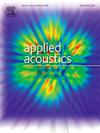基于单元件二维虚拟无源反转的UWA-OTFS通信接收机设计
IF 3.4
2区 物理与天体物理
Q1 ACOUSTICS
引用次数: 0
摘要
正交时频空间(OTFS)调制为提高移动水声通信系统的可靠性提供了一种新的解决方案。在本研究中,提出了一种针对UWA-OTFS通信量身定制的接收器架构,该架构利用延迟多普勒(DD)域的单元素二维虚拟无源反转(2D-VPR)技术。为了提高2D-VPR均衡后等效信道中主瓣能量的集中程度,提出了一种带动态功率加权(BOMP-DPW)的分组正交匹配追踪信道估计器,使通信系统的原始误码率(BER)降低了一个数量级。此外,考虑到信号失真和噪声的影响,由BOMP-DPW估计器驱动的2D-VPR处理器与最小均方误差(MMSE)均衡器耦合,进一步抑制副瓣干扰和噪声。提出的方案在南海进行了测试,数据处理结果证实接收机在2 - 4 kHz频带内实现了可靠的通信,数据速率为1.8 kbps,最大牵引距离为5 km,发射机和接收机之间的相对速度为2 m/s。本文章由计算机程序翻译,如有差异,请以英文原文为准。
Design of an UWA-OTFS communication receiver based on single-element two-dimensional virtual passive reversal
Orthogonal Time Frequency Space (OTFS) modulation offers a novel solution to enhance the reliability of mobile underwater acoustic (UWA) communication systems. In this study, a receiver architecture tailored for UWA-OTFS communication is presented, leveraging single-element two-dimensional virtual passive reversal (2D-VPR) technology in the delay-Doppler (DD) domain. To enhance the concentration of main lobe energy in the equivalent channel after 2D-VPR equalization, a block orthogonal matching pursuit with dynamic power weighting (BOMP-DPW) channel estimator is proposed, resulting in an order-of-magnitude reduction in the communication system's raw bit error rate (BER). Furthermore, considering the impact of signal distortion and noise, the 2D-VPR processor driven by the BOMP-DPW estimator is coupled with a minimum mean square error (MMSE) equalizer to further suppress sidelobe interference and noise. The proposed scheme was tested in the South China Sea, where data processing results confirmed that the receiver achieved reliable communication within a frequency band of kHz, a data rate of 1.8 kbps, a maximum towing distance of 5 km, and a relative speed of 2 m/s between the transmitter and receiver.
求助全文
通过发布文献求助,成功后即可免费获取论文全文。
去求助
来源期刊

Applied Acoustics
物理-声学
CiteScore
7.40
自引率
11.80%
发文量
618
审稿时长
7.5 months
期刊介绍:
Since its launch in 1968, Applied Acoustics has been publishing high quality research papers providing state-of-the-art coverage of research findings for engineers and scientists involved in applications of acoustics in the widest sense.
Applied Acoustics looks not only at recent developments in the understanding of acoustics but also at ways of exploiting that understanding. The Journal aims to encourage the exchange of practical experience through publication and in so doing creates a fund of technological information that can be used for solving related problems. The presentation of information in graphical or tabular form is especially encouraged. If a report of a mathematical development is a necessary part of a paper it is important to ensure that it is there only as an integral part of a practical solution to a problem and is supported by data. Applied Acoustics encourages the exchange of practical experience in the following ways: • Complete Papers • Short Technical Notes • Review Articles; and thereby provides a wealth of technological information that can be used to solve related problems.
Manuscripts that address all fields of applications of acoustics ranging from medicine and NDT to the environment and buildings are welcome.
 求助内容:
求助内容: 应助结果提醒方式:
应助结果提醒方式:


